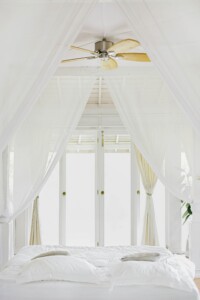
What constitutes a balanced room according to feng shui theory involves not one, but several aspects. Some of those aspects are non-obvious while some aspects are immediately palpable, such as the flaw of a room which is chronically dark or cold.
The look of exposed beams can be architecturally stunning, but when large looming beams hover over a person’s bed, they can create an unbalanced flow of qi (air currents) within the room. This can have a predictable affect on the person sleeping below.
For example, if a large exposed beam hovers over your waist, it could undermine fertility or cause digestive problems. A large beam that crosses over the knees could trigger or worsen knee problems. When the beam travels length-wise over the middle of the bed, the couple sleeping below can feel divisive. It is as if an invisible curtain divides the connection between the two people.
Feng Shui is a 3,000+ year old metaphysical practice, originating in China, but relevant to everyone since it deals with energy, nature, laws of physics and the environments we all create. The harmful effect of exposed beams is well-documented and a basic feng shui principle is that flat, beamless ceilings are much healthier to sleep under.
What do you do if you have exposed beams in your house? Well, if the room is big enough to handle a four-poster canopy bed, the fabric draped over the frame can work as a faux ceiling and deflect away the downward pressure of the beam. Some people are actually able to drop the ceiling in a remodel and thus eliminate the exposed beams entirely. This is only recommended if you will feel comfortable with the lower height of the ceilings.
Exposed beams in other rooms of the house, such as a den or dining room, should not be a concern. The beams are only a potential problem if you sleep under them or work long hours under them.
Author: Kartar Diamond
Company: Feng Shui Solutions (R)
From the Architecture and Design Blog Series
